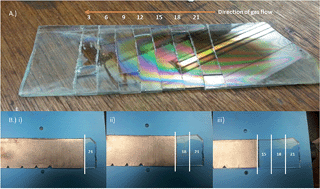The use of time resolved aerosol assisted chemical vapour deposition in mapping metal oxide thin film growth and fine tuning functional properties†
Abstract
Time resolved analysis of a thin film has allowed, for the first time, analysis of how thin film growth occurs and changes over time by aerosol assisted CVD. This method has also allowed tuning of the materials' functional properties. In this report a hydrophobic and highly photocatalytic TiO2/SnO2 system is studied, which exhibits surface segregation of SnO2 and thus the novel formation of a natural hetero-junction charge transfer system. The time resolved samples were investigated by a variety of methods. The films were characterised by X-ray diffraction (XRD), X-ray photoelectron spectroscopy (XPS), scanning electron microscopy (SEM) and Ultraviolet-visible absorption spectroscopy (UV-vis). Functional properties were investigated by photo-activity measurements and water contact angles before and after UV irradiation. The generation of representative samples at different times during the deposition sequence permitted changes in crystal structure, relative concentrations of atoms, and surface morphology to be linked intrinsically to changes in functional properties.


 Please wait while we load your content...
Please wait while we load your content...